| The Christie Tank in the USSR |
|---|
|
|

| The Christie Tank in the USSR |
|---|
|
|

| Note: All Russian terms and abbreviations shown as red italic are described in the Glossary. |
The end of the 1920s and beginning of the 1930s was characterized by the gradual sharpening of the struggle between various governments, which brought into greater focus the origins of World War II. Active military preparations took the form of actual growth of armies, modernization of armaments, and the militarization of economies and all aspects of societal life. The primary tendency in the development of armies of this period was their mechanization and motorization, the equipping of forces with tanks, aircraft, automatic weapons, artillery, and mortars.
 Assembly of the chassis of the Christie tank, model-1930, at the plant in Rahway, New Jersey, USA |
At this time the USSR was forced to take extreme measures to accelerate the development of its own defense industry, to re-equip the Armed Forces and for subsequent improvement of their combat capability. In July 1929 the Soviet government approved the first tank program, the goal of which was to bring into the inventory tankettes, light tanks, armored cars, self-propelled guns, tracked armored transporters, and other special vehicles.
At the end of November 1929, in connection with the falling behind of our own industry in the development of production of all types of tanks that met the armament requirements of the day, the chairman of the Revvoensoviet K. E. Voroshilov gave a report to the Council of Labor and Defense. On the basis of this report on 5 December a commission under the leadership of the deputy chairman of the SNK G. K. Ordzhonikidze decided to send abroad representatives of the military enterprises and industry to acquire examples of armaments and receive technical assistance regarding their production.
The commission, headed up by the chief of the UMM of the RKKA, I. A. Khalepskiy, went abroad on 30 December 1929. Having visited Germany, Czechoslovakia, France, and Great Britain, the commission arrived in the USA for the purpose of purchasing the small tanks T-1 and E-1 from the Cunningham firm. The results of tests that had been conducted indicated that these vehicles possessed a movement speed some 8 km/h less than the English Vickers tank that had already been purchased. The engine and transmission constantly overheated and the enormous tracks were an obstacle to the achievement of the desired movement speed. At the same time, the price of these two tanks was 175.5 thousand rubles higher and the commercial demands of the Cunningham firm were absolutely unacceptable: its representatives set forth conditions in accordance with which the Soviet side was to purchase a minimum of 50 vehicles with a 50 percent down payment. In addition, the firm categorically refused to provide technical assistance or engineers to visit Soviet production facilities. For all of these reasons talks regarding the purchase of these tanks were broken off.
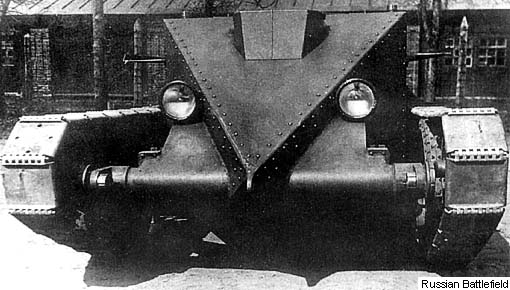
On this same trip the commission representatives became acquainted with John Walter Christie and his fast tank, which at that time was still being designed. Contrary to expectations, the tanks did not make the desired impression on the head of the commission, I. A. Khalepskiy, who at the time was still enthralled with the TG tank designed by German engineer E. Grotte. But just the same Khalepskiy had brought with him a tentative agreement for the possible purchase of a Christie tank. When it came down to securing the ability to produce these tanks, the Soviet government loosened its purse strings.
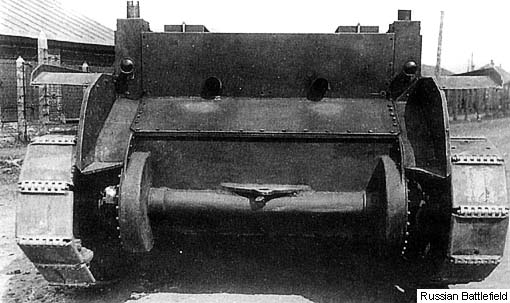
Having agreed on a number of issues, the USSR purchased from John Christie two improved experimental tank chassis, named by the designer the M-1930 (model 1930). Here it should be emphasized that despite what has been written in many publications, not whole tanks were purchased but only their chassis.
The primary reason for the purchase of the Christie M-1930 tank was first of all the technical assistance offered by the firm, and the delivery of all production blueprints and the technological process of the production of the tank. John Christie also expressed his willingness to come to the USSR for a period of two months for consultations and to help organize production. In addition, the firm gave the opportunity to our engineer to work at the plant in Rahway, New Jersey. This technical assistance was not extended for the "Liberty" engine, because these were already being produced in the USSR under license under the label "M-5".
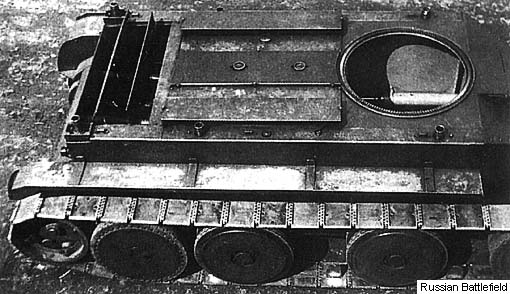
The issue of whether the sale of the Christie tanks was confirmed in writing or only by an oral agreement has been discussed in various ways in many publications. Judging by available documents, adherents of both sides are correct. Indeed, on 28 April 1930 an agreement was signed between the firm "U.S. Wheel Track Layer Corporation" and AMTORG (the trade organization that represented the interests of the USSR in the USA) for the delivery to the Soviet Union of "two military tanks with a total cost of $US 60,000. Delivery of the tanks is to be accomplished not later than four months from date of agreement signing." In the document the parties also agreed to: "Delivery of spare parts for the purchased tanks for the sum of $US 4,000, and also the right of production, sale, and use of the tanks inside the borders of the USSR for ten years" (Russian State Military Archive RGVA, Collection 31811, file 374, sheets 5, 6). Christie was paid an additional $100,000 for sale of production rights, transfer of patents, and services in the area of technical cooperation. John W. Christie, president of the corporation, signed the agreement on the American side and A. V. Petrov, president of AMTORG, signed on the Soviet side in the presence of I. A. Khalepskiy (USSR), John Michael, John Raymond, and Tiffany (all of the USA). Altogether the Soviet Union had to pay the sum of $US 160,000.
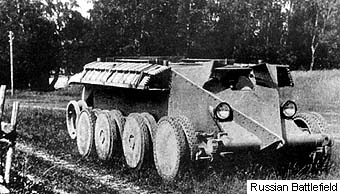 First experimental Christie tank "Original-1" in the USSR |
However, there was also an oral agreement between Christie and Khalepskiy. Khalepskiy referred to this in his report about the visit to the USA.
"During my visit with Christie no documents were signed, but an oral agreement was reached regarding the sale of two tanks to us."
Christie, in his own 7 October 1931 letter to the AMTORG director, Gobar, states:
"In this letter I draw for the last time your attention to the agreement personally reached between Mr. Khalepskiy, yourself, the author of this letter [Christie - trans.], and other members of your commission, who were witnesses to the fact that the contract concluded with me orally should be fulfilled notwithstanding the legal technical requirements and changes."
Based on all of this, it can be concluded that Soviet military personnel indeed reached an oral agreement with Christie for the delivery of tanks. And because at that time the Soviet Union and the United States did not have diplomatic relations, in order to export the tanks without problems a written agreement had to be signed with AMTORG, the single organization that officially represented the trade interests of the USSR in the USA.
Having returned from the USA in June 1930, Khalepskiy presented to the RVS a report regarding his foreign travel in which the Christie tank was characterized as an extremely fast-moving tank with independent wheel-track movement:
"Taking into account that by its speed the Christie surpasses all other tanks in the world, and that the Poles intend to build it [here it should be made clear that Poland was considered the most probable enemy of the USSR at this time- Valera P.], we could fall into a very unfavorable position from the point of view of tactical employment of tank units. In connection with this, I urgently recommend that we press ahead with the production of the Christie tank by reducing the production of the Liberty engine in aviation plants and preparing for the production of other components at the Yaroslavl Automobile Plant. I recommend that for the current 1930-31 years we give industry the task of building not less than 100 Christie tanks."
However, despite of some publications state "the Russians were fascinated by genius Christie tank", in this report it estimates quite conservative:
"...Despite of its high speed that, by assurance of the Americans, exceeds 45 km/h on tracks and 70 km/h on wheels... this tank is not good enough to be accepted for service".
It turned out that the Christie tank was viewed rather as a temporary measure for the creation of our own fast tank.
 Christie tank before beginning of testing, 1931. |
The matter of the production of the Christie tank at Yaroslavl Automobile Plant was discussed at an expanded session of the RVS with industry representatives, which was convened from 1 to 5 July 1930, under the agenda topic, "Regarding tank issues."
For the purposes of studying the organization of production and control for the fulfillment of the order, a member of the NTK, N. M. Toskin, arrived in New York on 14 July 1930. Making contact with the designer of the ordered vehicles, he received on behalf of Khalepskiy 127 pages of blueprints of the experimental tank and an assurance that Christie intended to come to Moscow with the vehicles.
The blueprints arrived in Moscow on 9 August 1930 and were immediately transferred to the head designer of the main design bureau under the auspices of the State All-union Gun-Armaments-Machine Gun Enterprise, S. P. Shukalov. After copies of these blueprints were made, on 13 October 1930 all of them were returned to the ABTU.
�In accordance with the agreement, Christie was required to deliver two vehicles by September 1930 to a representative of AMTORG. But, despite his best efforts, he managed fully to complete these vehicles only by the end of that year. The assembled and tested vehicles were shipped from New York to the USSR in the last days of December 1930.
Meanwhile, on 21 November 1930, the RVS of the USSR approved the Christie tank for production. The question regarding the designation of this tank had arisen somewhat earlier, in view of the fact that all designations up through T-34 had already been assigned for three years hence. However, the decision of the head of the UMM, expressed in a letter of 11 January 1931, was firm:
"Since the American Christie tank does not meet the requirements of a tank-tractor-armored combat vehicle, and has not been accepted into the inventory, it will not receive the comprehensive designation "T". The suggestion to give it the designation "ST" or "BT" [skorostnoy tank or bystrokhodnyy tank, both of which mean "fast tank" in English - trans.] is more rational."
This same decision led to the conspicuous name "Soviet Christie". An order of the VSNKh of the USSR was issued on 23 May 1931, which decreed that the Christie tank was to be introduced into the "system of tank-tractor-armored car armaments of the RKKA" as a tank destroyer.
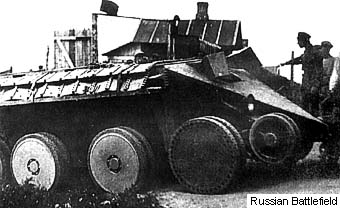 ����� �������� ����������� ���� ������. ������ 1931 �. |
Both vehicles that arrived in the USSR in early 1931 were subjected to careful examination and testing. In particular, the tank that had the factory number 2051 was received on 4 March 1931 for examination at depot #127 of the ABTU. After brief familiarization with the tank by representatives of the UMM of the RKKA, on 14 March this test model arrived at the testing department, where, in accordance with instructions of the chief of UMM of the RKKA, familiarization with its technical components and demonstration of the purchased vehicle was conducted until 16 May under the guidance of the chief of the section Gromov and engineer of the tank station Lavrentev. Countless delegations of the leadership component of the RKKA were familiarized with the new item from the end of March to 16 April, on the whole creating a good impression on them. Therefore a joint session "Concerning the tank program for the plant for 1931" was convened at the "Bolshevik" plant on 24 April 1931. The list of participants at this session attests to the importance of the question under consideration: K. E. Voroshilov, Tukhachevskiy, Slavin (RVS LVO [Revolutionary Military Council of the Leningrad Military District]), Karpenko (OGPU), Litunovskiy, Khalepskiy, Lebedev (UMM), Salnikov (plant director), K. K. Sirkin, Zabrezhevskiy (plant technical director), and as well other representatives of the plant and workshops.
The resolution that came out of this session stated in part:
"The plant accepts the order for production in the current year (1931) of 100 "BT" (Christie) tanks under the conditions of supply of its rolled hardened armor, the development of the working blueprints of which will be carried out by a special tank design bureau, which at the present time is completing the working blueprints for the T-26. In connection with the production of the "BT", future output of the T-18 is hereby eliminated."
However these plans would not be realized. In fact, the financial planning commission of the NKV noted the production of 150 "TG" medium tanks of the German designer E. Grotte. But because of delay in the preparation of a test model of the new type of medium tank, the deputy chairman of the RVS Uborevich on the suggestion of Khalepskiy decided to order production of 200 T-24 medium tanks in place of the TG at the KhPZ. But because a production agreement had not been concluded even by the end of 1931, at the beginning of May, 1932, the Commission for the Defense of the USSR revisited the issue of the possibility of production of the Christie BT at the KhPZ.
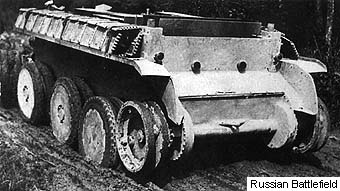 ���� ������ �� ����������. ����� 1931 �. |
The selection was not accidental, since the plant's production base permitted practically complete preparation of the tank. By cooperation it was planned to prepare only radiators, conical drive hubs for the transmission and cast parts of high-quality steel.
�Here it is necessary to note that the KhPZ began the organization of tank production from the basis of some experience. The plant staff had gained some experience in the repair of captured foreign tanks already in 1920-23, when the plant repaired approximately 30 captured tanks. The plant had been serially producing "Kommunar" track-laying tractors since 1924 and had now transitioned to the construction of more powerful and modernized "Komintern" tractor. Beginning in 1925 the plant had begun to use gas and electric welding in the production of steam locomotives. The cadre of workers, managers, designers, metallurgists, and technicians had grown during these years.
�In a 17 May 1931 order of the Peoples' Commissar for Military and Naval Affairs, the chief of the UMM RKKA devised a plan for accomplishment of the government's decision for organization of production of the Christie BT at KhPZ. This plan envisioned:
"1. Preparation of the working blueprints by 15.07.31 (one month) by SKB under the supervision of the chief of the design bureau of the armaments combine S. A. Ginzburg using 20 engineers and designers from GKB #8 of the armaments combine; 15 engineers and designers from NATI VATO; two hull designers from Izhorsk Plant; from UMM, Toskin as deputy chief of the design bureau and Rozhkov as designer for ammunition and turret production; and the full staff of the KhPZ Aleksenko tank design bureau. In addition, from 10.06 the director of the KhPZ supports the bureau with 30 copiers [people who reproduced blueprints by hand - Valera P.].
2. Five highly qualified specialists from Ukrgipromash for development of the technical processes of production of the tank.
3. Assemble the KhPZ BT special bureau by 25.05.31.
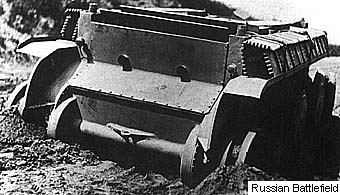 Christie tank mired in sand |
4. Prepare three test models by 15.09.31, two by KhPZ and one by the test section of the "Bolshevik" plant with delivery of castings and forgings from KhPZ.
5. Preparation of the first run of 100 tanks: 20 by 01.11.31 [1st November - trans.], 30 by 30.12., and 50 by 01.01.32."
(RGVA Collection 4, index 14, file 505, sheet 131)
Practically all five points of this plan formed the basis of the Order of the VSNKh #73 of 21.05.31 regarding the organization of production of the BT at KhPZ and the creation of the design bureau. The final decision on organization of production of the Christie tank was reflected in Protocol #6 of the Commission of Defense, "Concerning tank design," of 23 May 1931:
"The RVS USSR is permitted to introduce the Christie tank into the system of Auto-Armored-Tank-Tractor Armaments of the RKKA as a fast tank destroyer (BT).
In ten days Voroshilov and Ordzhonikidze will have to reach final agreement on the maximum number of BT (in existing form, without any changes) that can be produced at KhPZ in 1931, bearing in mind the complete cancellation of orders for the T-24.
Simultaneously RVS is obligated to push forward for modernization of the Christie tank."
(RGVA Collection 4, index 14, file 505, sheet 115).
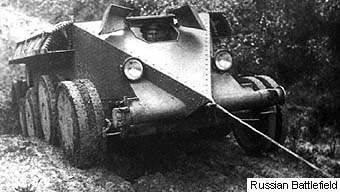 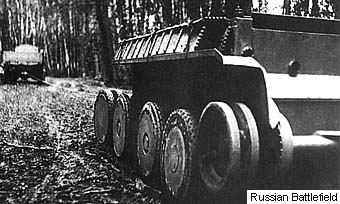 Towing a mired Christie tank. |
At this time work for study of the first model of the Christie had just begun at the test range. The tank that arrived for testing was a light combat wheeled-tracked vehicle with a classic arrangement. The forward portion of the hull contained the driver's compartment with a centrally positioned driver-mechanic. The middle portion of the hull held the combat compartment and the rear of the hull the engine-transmission compartment. The turret with armaments was absent. Entry of the crew into the tank was accomplished through the driver's hatch. The vehicle's crew consisted of two persons. Upon conduct of the technical inspection on 16 May 1931, it was determined that entry and exit of the two crew members was possible in 10 to 20 seconds, but only through the turret opening, because the forward (driver's) hatch was too narrow for passage.
The vehicle's armor was sufficient to protect the crew and internal components against small arms fire. The tank's hull was riveted from armor plates with a thickness of from 5.5 to 14 millimeters.
The engine-transmission compartment housed a 400 h.p. Liberty aircraft engine mounted longitudinally.
The driver-mechanic steered the tank with the aid of a detachable steering wheel. However, when necessary the tank could be turned in place using steering levers intended for driving the vehicle when it was moving on tracks. During movement on wheels the tracks were stowed on shelves above the wheels and secured to these shelves with leather straps.
The tank suspension was by individual springs. Each side of the tank housed four aluminum rubber-lined road wheels of 813 mm diameter. The guide and drive wheels for tracked movement had external rubber cushioning. The large-block track, consisting of 46 individual track blocks, interfaced with the drive wheels by means of large, flat "paddles".
An 800 kg ballast was installed in the tank in place of the absent turret with armament during testing. A number of deficiencies were revealed during the first external inspection, such as an absence of vision ports in the driver's hatch, and also the impossibility of access to the basic power plant assembly and transmission without removing the engine-transmission compartment cover.
The weighing of the tank with ballast, but without crew, was conducted on 16 May: 9360 kg. Automotive testing of the vehicle was begun on this same day. Over the next 10 days the tank was driven 150 km on wheels and tracks. The tank had been driven an additional 50 km earlier, during plant testing before its delivery to the USSR. The failure of John Christie to develop his tank design in full was immediately made obvious. On the second day of automotive testing, 17 May, during a turn on grass, the right idler arm mount broke (see photo). Two subsequent days were spent in repair of the tank. But the welding held for only 500 meters of movement on tracks. On 23 May, after a second broken right idler arm mount, the tank was again sent in for repair, which took three days to accomplish. The tank was subjected to running on hard surface and dirt roads only on its wheels from 27 May to 13 June. The maximum speed did not exceed 65 to 70 km/h. The impossibility of movement on wheels in sand because of significant miring in the soil turned out to be a substantial deficiency. |
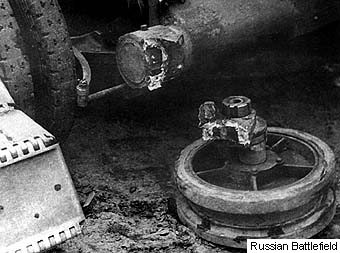 Broken right idler arm mount. |
The ability of the tank to overcome natural and man-made obstacles was demonstrated to government representatives on 7 June. But a full demonstration of the tank's capabilities was not possible because of the breaking of the idler wheel mount. The tank freely passed over five rows of barbed wire on its wheels, and then overcame a two-meter ditch.
The tank's crew spent 44 minutes in mounting the tracks, and after a 10-minute break spent 35 minutes in removing them and placing them back in their stowage position.
After the vehicle was demonstrated to the government representatives the testing was extended. On 13 June still another, last attempt was made to test the tank running on its tracks. But, after the tank had moved just 1 km, the ill-fated idler arm mount broke again. Three days later the gearbox began to malfunction in 2d and 3d gears.
During this entire period of testing from 16 May to 21 June the tank was driven 43.5 km on its tracks and 863 km on its wheels.
Some 15 pages of detailed data were collected as a result of testing. In particular, it was noted that the tank failed to undergo complete testing because of breakage of the idler arm mount.
"...The tank was tested only on its wheels, during which it was shown that the average speed on hard surface roads did not exceed 30 to 35 km/h. After 4 to 5 hours the driver was extremely tired (because of difficulty in steering and ride roughness). The engine worked well but frequent adjustment of the valves was necessary. The batteries are inadequate for starting of the engine (as a rule, a cold engine was started by towing).
After 600 to 650 km, 2nd and 3rd gears of the transmission malfunctioned under heavy engine loads. The lubricant leaks under pressure and shifting of all gears is difficult. After 2 to 3 hours of movement the transmission heats up to a temperature of 85° to 88°� in an ambient air temperature of 35° to 40°�.
Tracks. Eight pins broke after 40.5 kilometers.
Drive wheels. Disintegration of the exterior surface of 1.5 to 2 cm magnitude was observed after 150 to 200 kilometers.
Tank steering is satisfactory. On dirt roads it refuses to respond to the steering wheel, and during driving on uneven terrain the wheel can be snatched from the driver's hands. The vehicle is difficult to steer at 55 to 60 km/h...
CONCLUSIONS:
The Christie tank in that form in which it was presented for testing is an exceptionally interesting vehicle with universal drive. As a combat vehicle it requires significant development and the introduction of a number of design improvements and changes".
Already at this time, when automotive testing of the experimental model had begun, on 1 June 1931 the chairman of the NTK UMM RKKA (Lebedev) sent to the director of KhPZ (Vladimirov) a tasking approved by the Chief of UMM RKKA (Khalepskiy) for planning of the Soviet production of the wheeled-tracked BT tank.
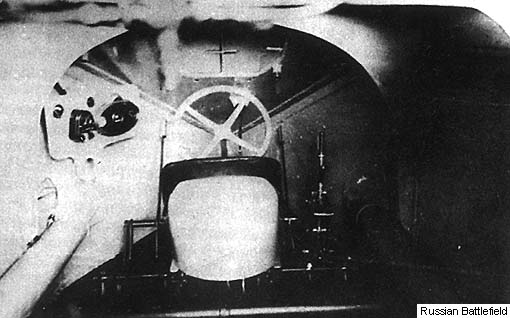
| Parameter | Christie M1928 (USA data) | Christie M1931 (USA data) | Tank BT Christie (UMM RKKA requirement document) |
| Year | 1928 | 1930 | 1931 |
| Crew | 3 | 3 | Not less than 3 |
| Combat weight, kg | 7 800 | 10 500 | 14 000 |
| Length, m | 5,18 | 5,50 | not specified |
| Width, m | 2,13 | 2,23 | not specified |
| Height, m | 1,83 | 2,28 | not specified |
| Armor, mm | 12,7 | 13-16 | Front of hull and turret-20 Side-13 Bottom, roof-6 |
| Armament | 2 x 7,62-mm | 1 x 37-mm 1 x 7,62-mm |
1 x 76-mm anti-assault* (temporary) 1 x 37-mm high power (future) 1 x 7.62-mm DTU |
| Ammunition | 7.62-mm: 3000 rds. | 37-mm: 126 rds. 7.62-mm: 3000 rds. |
76-mm: 40 rds 37-mm: 100 rds. 7.62-mm: 5000 rds. |
| Engine | Liberty, 6-cyl., gas, 338 h.p. | Liberty, 6-cyl., gas, 338 h.p. | Liberty, 6-cyl., gas, 338 h.p. |
| Maximum speed, km/h | 112 (on wheels) 68 (on tracks) |
75 (on wheels) 44 (on tracks) |
70 (on wheels) 40 (on tracks) |
| Range, km | 120/185 | 240 | Not less than 4 hrs. |
* Anti-assualt cannon was a forebear of the field regimental artillery. Such cannons characterised with relatively small weight.
| REFERENCES: Specification of Soviet tanks Specifications of Soviet tank guns |
Translated by:
James F. Gebhardt Sources: Russian State Military Archive, as cited "Tankomaster" No. 1, 1999 I. Zheltov, I. Pavlov, M. Pavlov, "Tanki BT. Part I", Armada #1 Cover picture by A. Aksenov |